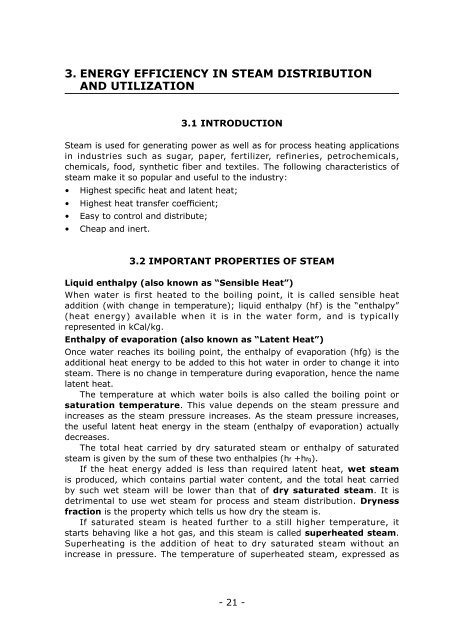Training Manual on Energy Efficiency - APO Asian Productivity ...
Training Manual on Energy Efficiency - APO Asian Productivity ...
Training Manual on Energy Efficiency - APO Asian Productivity ...
You also want an ePaper? Increase the reach of your titles
YUMPU automatically turns print PDFs into web optimized ePapers that Google loves.
3. ENERGY EFFICIENCY IN STEAM DISTRIBUTION<br />
AND UTILIZATION<br />
3.1 INTRODUCTION<br />
Steam is used for generating power as well as for process heating applicati<strong>on</strong>s<br />
in industries such as sugar, paper, fertilizer, refineries, petrochemicals,<br />
chemicals, food, synthetic fiber and textiles. The following characteristics of<br />
steam make it so popular and useful to the industry:<br />
• Highest specific heat and latent heat;<br />
• Highest heat transfer coefficient;<br />
• Easy to c<strong>on</strong>trol and distribute;<br />
• Cheap and inert.<br />
3.2 IMPORTANT PROPERTIES OF STEAM<br />
Liquid enthalpy (also known as “Sensible Heat”)<br />
When water is first heated to the boiling point, it is called sensible heat<br />
additi<strong>on</strong> (with change in temperature); liquid enthalpy (hf) is the “enthalpy”<br />
(heat energy) available when it is in the water form, and is typically<br />
represented in kCal/kg.<br />
Enthalpy of evaporati<strong>on</strong> (also known as “Latent Heat”)<br />
Once water reaches its boiling point, the enthalpy of evaporati<strong>on</strong> (hfg) is the<br />
additi<strong>on</strong>al heat energy to be added to this hot water in order to change it into<br />
steam. There is no change in temperature during evaporati<strong>on</strong>, hence the name<br />
latent heat.<br />
The temperature at which water boils is also called the boiling point or<br />
saturati<strong>on</strong> temperature. This value depends <strong>on</strong> the steam pressure and<br />
increases as the steam pressure increases. As the steam pressure increases,<br />
the useful latent heat energy in the steam (enthalpy of evaporati<strong>on</strong>) actually<br />
decreases.<br />
The total heat carried by dry saturated steam or enthalpy of saturated<br />
steam is given by the sum of these two enthalpies (hf +hfg).<br />
If the heat energy added is less than required latent heat, wet steam<br />
is produced, which c<strong>on</strong>tains partial water c<strong>on</strong>tent, and the total heat carried<br />
by such wet steam will be lower than that of dry saturated steam. It is<br />
detrimental to use wet steam for process and steam distributi<strong>on</strong>. Dryness<br />
fracti<strong>on</strong> is the property which tells us how dry the steam is.<br />
If saturated steam is heated further to a still higher temperature, it<br />
starts behaving like a hot gas, and this steam is called superheated steam.<br />
Superheating is the additi<strong>on</strong> of heat to dry saturated steam without an<br />
increase in pressure. The temperature of superheated steam, expressed as<br />
- 21 -
















